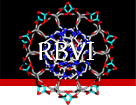

 about
projects
people
publications
resources
resources
visit us
visit us
search
search
about
projects
people
publications
resources
resources
visit us
visit us
search
search

RBVI's "Visualization Vault"
Virtual Reality
The Viz Vault is also equipped with an HTC Vive virtual reality headset for immersive views of molecular structures, 3D light microscopy and electron microscopy using our ChimeraX VR software. The user sees holographic room-size atomic models and microscopy data, and can literally walk through the data to ideal vantage points and analyze the data using tracked hand controllers for clicking on objects in the scene. The headset is powered by an NVIDIA Quadro P6000 graphics card.Stereoscopic Projector
The Viz Vault uses a Christie Digital Mirage S+4K video projector (1400x1050 resolution) capable of 120Hz vertical refresh rate. The fast vertical refresh allows images to be displayed at 120 frames per second. For viewing stereoscopic 3-D images, a slightly different image is projected every other frame. The projector is coupled to an infrared (IR) emitter which floods the room with invisible IR light during one of these frames, but not the other. Users then don a pair of liquid crystal "shutter" glasses such as RealD's CrystalEyes 4S with lens that alternately turn opaque, first for one eye and then for the other eye. The glasses are synchronized to the different images from the projector via the IR light beam, and the result is that the user perceives a three-dimensional image that appears to be floating in space in front of the projector screen. A workstation running Windows 10 and a NVIDIA Quadro P6000 graphics card with hardware stereo synchronization drives the system (NVidia driver version 430.39, April 23, 2019, flat panel must be the primary display). [This system has reached end-of-life and will be replaced soon.]Enhanced Understanding of Complex Biological Structures
Both VR and stereoscopic viewing are especially useful for understanding the complex spatial relationships inherient in large molecular structures such as viruses, proteins, and nucleic acids, and the details of these relationships are often critical to understanding how these molecules deliver their biological function.
About RBVI | Projects | People | Publications | Resources | Visit Us
Copyright 2018 Regents of the University of California. All rights reserved.